Welding is a fundamental joining technique essential in modern manufacturing. This PDF guide provides an overview of welding processes, safety practices, and resources for professionals and beginners alike.
Overview of Welding Processes
Welding processes involve joining materials, typically metals, through heat, pressure, or both. Common methods include MIG/MAG, TIG, Shielded Metal Arc (SMAW), Plasma, and Submerged Arc Welding (SAW). Each process offers unique advantages, such as precision, speed, or adaptability to different materials. These techniques are widely applied in industries like automotive, aerospace, and construction. This section provides a concise guide to understanding the basics and applications of these welding methods, helping professionals and learners select the most suitable process for their needs.
Importance of Welding in Modern Industry
Welding is a cornerstone of modern industry, enabling the fabrication and repair of critical infrastructure, machinery, and transportation systems. It plays a vital role in manufacturing, construction, automotive, aerospace, and energy sectors. High-quality welds ensure structural integrity, safety, and durability in products ranging from vehicles to bridges. Welding also drives innovation, supporting advancements in technology and materials science. As industries evolve, the demand for skilled welders and advanced techniques continues to grow, making welding an essential skill for economic development and global competitiveness.
Types of Welding Processes
Common welding processes include MIG/MAG, TIG, Shielded Metal Arc (SMAW), Plasma, and Submerged Arc Welding (SAW). Each offers unique advantages for specific materials and applications.
MIG/MAG Welding
MIG (Metal Inert Gas) and MAG (Metal Active Gas) welding use a continuous wire electrode and inert/active gases for shielding. Ideal for steel, stainless steel, and aluminum, these processes offer high speed, clean welds, and minimal slag. Widely used in automotive, construction, and manufacturing industries due to their versatility and efficiency. Suitable for thin and thick materials, MIG/MAG welding is known for its smooth, spatter-free results. Proper parameter setup, including voltage and wire feed speed, ensures optimal weld quality. Common applications include sheet metal work, pipeline welding, and robotic automation in industrial settings. A popular choice for both professionals and hobbyists.
TIG Welding
TIG (Tungsten Inert Gas) welding uses a non-consumable tungsten electrode and inert gases to shield the weld. Known for high-quality, precise welds, it excels in joining thin materials and exotic metals like stainless steel and aluminum. TIG welding offers exceptional control over the weld pool, making it ideal for intricate joints and high-purity applications. Common in aerospace, automotive, and artistic metalwork, it produces clean, slag-free results. While slower than MIG/MAG, its versatility and ability to weld dissimilar metals make it indispensable for specialized tasks. Requires skilled operators to maintain optimal weld integrity and aesthetic appeal in demanding industrial and creative projects.
Shielded Metal Arc Welding (SMAW)
Shielded Metal Arc Welding (SMAW), commonly known as “stick” welding, uses a consumable electrode covered in flux. The flux generates a protective shield, preventing atmospheric contamination and reducing oxidation. SMAW is highly versatile, suitable for various metals, including steel and cast iron. It’s portable and effective in outdoor conditions, making it ideal for construction and repair work. The process involves striking an arc between the electrode and workpiece, creating a molten weld pool. SMAW requires skill to manage electrode handling and slag removal, but its simplicity and adaptability make it a cornerstone in many industries for maintenance, construction, and heavy fabrication tasks.
Plasma Welding
Plasma welding is a high-precision, high-energy process utilizing ionized gas to create an intense arc. This process is ideal for thin materials and applications requiring minimal distortion. Unlike TIG welding, plasma welding uses a constricted arc, enhancing heat concentration and reducing thermal spread. It’s commonly used in automotive and aerospace industries for its high-quality, repeatable results. Plasma welding excels in joining materials like stainless steel and aluminum, offering superior penetration and reduced porosity. Its controlled environment makes it suitable for high-purity applications, ensuring strong, durable welds with minimal post-processing requirements. This method is preferred for critical components requiring accuracy and reliability.
Submerged Arc Welding (SAW)
Submerged Arc Welding (SAW) is a high-efficiency process where the arc is submerged under a layer of flux, protecting the weld from atmospheric contamination. This method ensures deep penetration and uniform weld quality, making it ideal for thick materials like steel. SAW is widely used in shipbuilding, construction, and heavy machinery industries. The flux layer not only shields the arc but also reduces UV emissions and fumes, improving safety. Post-weld slag removal is required, but the process offers high productivity and consistent results. SAW is particularly advantageous for long, straight welds, and its automation capabilities make it suitable for large-scale industrial applications requiring precision and strength.
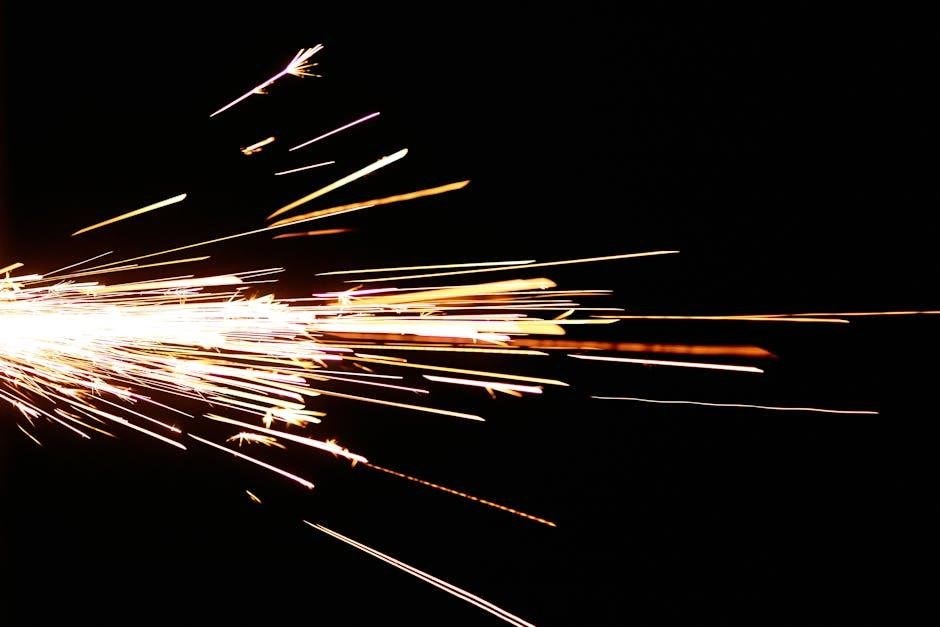
Welding Safety Practices
Ensure a safe welding environment by removing flammables, using proper PPE, and maintaining ventilation to prevent fire hazards and exposure to harmful fumes or sparks.
Personal Protective Equipment (PPE)
Personal Protective Equipment (PPE) is critical for safeguarding welders from hazards like sparks, heat, and harmful fumes. Essential PPE includes welding helmets with shaded lenses to protect eyes from UV/IR radiation, safety glasses, and face shields. Fire-resistant clothing, gloves, and steel-toe boots prevent skin burns and injuries. Ensure PPE is well-maintained and suitable for the specific welding process. Proper ventilation and respiratory protection are also vital when working in confined spaces or with hazardous materials. Always follow guidelines for helmet shade numbers based on amperage to ensure optimal eye protection during welding operations.
Work Area Safety Tips
A clean and organized workspace is essential for safe welding. Remove flammable materials and ensure proper ventilation to prevent gas accumulation. Keep emergency equipment, like fire extinguishers, nearby. Avoid clutter to reduce tripping hazards and ensure good lighting for visibility. Use non-flammable covers for surfaces and ensure all equipment is grounded to prevent electrical shocks. Regularly inspect tools and cables for damage. Maintain a safe distance from combustible materials and never weld in areas with explosive atmospheres. Proper housekeeping and adherence to these tips significantly reduce accident risks during welding operations.
Hazard Control Measures
Implementing hazard control measures is critical to ensure a safe welding environment. Use engineering controls like fume extraction systems to minimize airborne contaminants. Administrative controls, such as training programs and procedure guidelines, help prevent accidents. Personal Protective Equipment (PPE) like welding helmets, gloves, and fire-resistant clothing is essential. Regularly inspect equipment and work areas to identify potential hazards. Establish emergency response plans for fires or spills. Proper storage of flammable materials and electrical safety measures further reduce risks. These measures collectively create a safer workspace and protect workers from welding-related hazards, ensuring compliance with safety standards and regulations.

Welding Consumables and Materials
Welding consumables and materials include electrodes, filler wires, fluxes, and shielding gases, each crucial for the welding process and joint strength.
Electrodes and Filler Wires
Electrodes and filler wires are critical components in welding, ensuring strong and durable joints. Shielded Metal Arc Welding (SMAW) uses flux-coated electrodes, while Gas Metal Arc Welding (GMAW) employs continuous filler wires. Electrodes are classified by their material and intended use, with options for steel, stainless steel, and nickel alloys. Filler wires, used in MIG/MAG and TIG processes, are designed to match base metal properties for optimal strength and corrosion resistance. Proper selection of electrodes and wires is essential for achieving high-quality welds, as they directly impact the mechanical properties and appearance of the finished joint.
Fluxes for Submerged Arc Welding
Fluxes play a vital role in Submerged Arc Welding (SAW) by protecting the molten weld area from atmospheric contamination. They form a slag layer, ensuring clean welds and stabilizing the arc. Fluxes are available in powder or granular form and are selected based on the material being welded. They reduce oxide inclusions, porosity, and improve weld quality. Different fluxes are designed for specific metals, such as steel, stainless steel, or nickel alloys. The composition of fluxes can vary to optimize weld penetration, mechanical properties, and slag detachability. Proper flux selection is critical for achieving desired weld characteristics in SAW applications.
Shielding Gases for GMAW
Shielding gases are essential in Gas Metal Arc Welding (GMAW) to protect the weld area from atmospheric contamination. Commonly used gases include Argon, Helium, and mixtures of both. These inert gases prevent the molten weld pool from reacting with oxygen and nitrogen, reducing porosity and ensuring clean welds. Argon is widely used for its stability and ability to produce a smooth arc, while Helium enhances penetration and heat transfer. The choice of gas depends on the material being welded, such as steel or aluminum, and the desired weld properties. Proper shielding gas selection is critical for achieving high-quality, defect-free welds in GMAW processes.
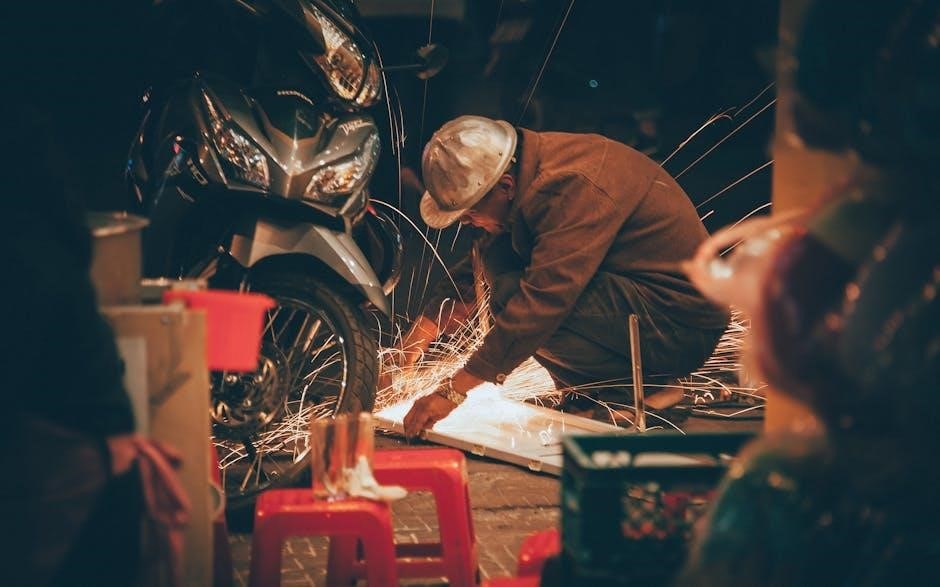
Welding Standards and Guidelines
Welding standards, such as AWS and ISO/EN, provide guidelines for procedures, materials, and safety. They ensure consistency, quality, and compliance in welding practices across industries.
American Welding Society (AWS) Standards
The American Welding Society (AWS) develops and publishes over 350 standards for welding practices, materials, and safety. These standards ensure consistency, quality, and compliance across various industries. Key standards include AWS A5.1-00 for welding electrodes and AWS D1.1 for structural steel welding. They provide guidelines for electrode classification, welding procedures, and inspection criteria. Adhering to AWS standards enhances weld quality, safety, and reliability. These documents are essential for professionals to maintain industry excellence and certification. They are regularly updated to reflect advancements in technology and best practices, ensuring they remain relevant and effective in modern welding applications.
International Welding Standards (ISO, EN)
International welding standards, such as those from ISO and EN, provide a global framework for welding practices, materials, and quality assurance. ISO 15607 and ISO 4063 address qualification of welding personnel and symbols, respectively. EN 1090 focuses on steel structure welding, while EN ISO 14341 covers MIG/MAG welding. These standards ensure consistency, safety, and compatibility across borders, facilitating international trade. They are widely adopted in industries like aerospace, automotive, and construction. Adhering to ISO and EN standards ensures compliance with global best practices, enhancing product quality and reliability. They are regularly updated to incorporate technological advancements and industry feedback.
Welding Codes and Specifications
Welding codes and specifications are essential for ensuring the quality, safety, and consistency of welded joints. Codes like AWS D1.1 (Structural Welding Code) and ASME Section IX (Welding and Brazing Qualifications) provide detailed guidelines for materials, procedures, and inspections. These documents outline requirements for welder qualification, procedure qualification, and non-destructive testing. Compliance with these codes is crucial for maintaining structural integrity and meeting industry standards. They also address specific applications, such as pressure vessels or steel construction. By following these codes, professionals ensure that welds meet rigorous safety and performance criteria, minimizing the risk of defects and failures. Regular updates reflect advancements in welding technology.

Welding Design and Joint Preparation
Welding design involves creating efficient joints and preparing edges for optimal results. Proper fit-up and alignment ensure structural integrity, while precise preparation minimizes defects and enhances weld quality.
Principles of Welding Design
The principles of welding design focus on ensuring structural integrity and durability. Key considerations include stress distribution, joint geometry, and material compatibility. Proper alignment and fit-up minimize warping, while the selection of appropriate welding processes and filler materials ensures strength. Designers must also account for thermal expansion and contraction to prevent cracking. By adhering to established standards and guidelines, such as those from the American Welding Society, engineers can create efficient and safe weld designs. Effective planning in the design phase significantly impacts the quality and longevity of the final welded product.
Types of Weld Joints
Weld joints are classified into five primary types: butt, lap, tee, corner, and edge joints. Each type is selected based on the specific application and design requirements. Butt joints involve end-to-end alignment, ideal for straightforward load-bearing applications. Lap joints overlap two pieces, offering strong resistance to bending and shear stresses. Tee joints connect two pieces at a right angle, commonly used in frameworks; Corner joints are used for boxing shapes, while edge joints connect edges of two pieces. Understanding these joint types is crucial for designing efficient and durable welded structures, ensuring proper load distribution and minimizing potential failure points.
Edge Preparation and Fit-Up
Proper edge preparation and fit-up are critical for achieving high-quality welds. Edges must be clean, free from contaminants, and precisely aligned. Common preparation methods include machining, grinding, or cutting to ensure smooth, even surfaces. The joint design dictates the required edge geometry, such as square, bevel, or V-shapes. Correct fit-up minimizes gaps and misalignment, reducing distortion and ensuring uniform weld penetration. Tight fit-up also prevents defects like porosity and lack of fusion. Proper edge preparation enhances weld strength, durability, and aesthetic appeal, making it a foundational step in successful welding processes across various industries and applications. Precision is key to optimal results.
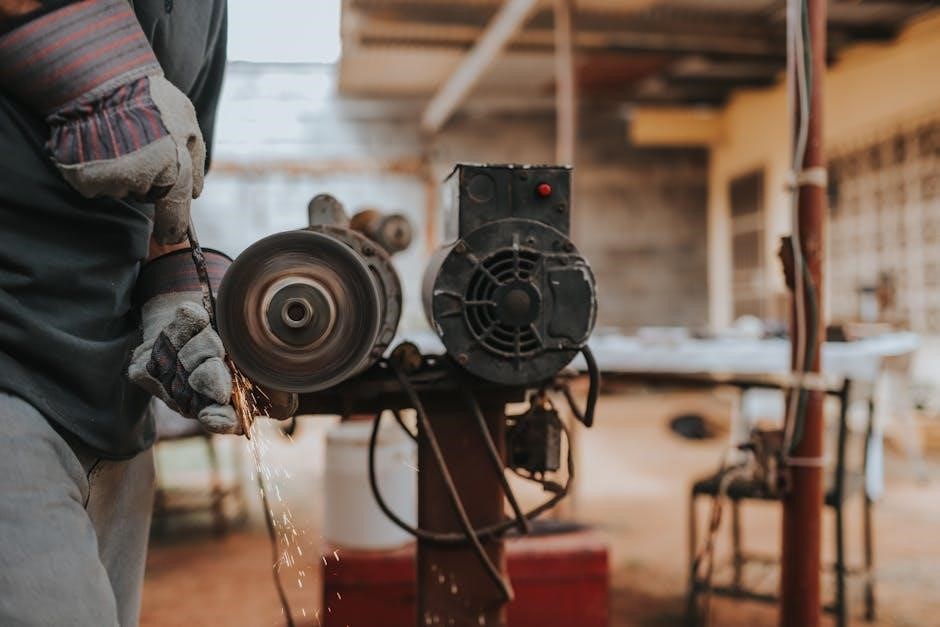
Welding Equipment and Power Sources
Welding equipment includes machines, torches, and wire feeders, while power sources range from AC/DC units to engine-driven systems, ensuring precise control for various welding processes and materials.
AC and DC Welding Machines
AC and DC welding machines are essential for various welding processes, offering distinct advantages. AC machines are known for their efficiency, typically ranging from 80 to 85%, and are often used in TIG welding due to their ability to produce a stable arc. DC machines, including transformer-rectifier sets, provide consistent current flow, making them ideal for processes like MIG/MAG and TIG welding. DC units can deliver up to 600 amps, suitable for heavy-duty applications. The choice between AC and DC depends on the specific welding process, material type, and desired weld quality, ensuring versatility and precision in achieving optimal results.
Transformer-Rectifier Welding Sets
Transformer-rectifier welding sets are versatile power sources that convert AC input to DC output, ideal for processes like TIG and MIG welding. These sets combine a transformer to step down voltage and a rectifier to convert AC to DC, ensuring a stable current flow. Known for their high efficiency, transformer-rectifier sets are compact and suitable for both light and heavy-duty applications. They are widely used in industries requiring precise control over welding parameters, offering consistent performance and reliability for achieving high-quality welds;
Plasma Cutting Equipment
Plasma Cutting Equipment
Plasma cutting equipment uses a high-velocity jet of ionized gas to cut through conductive materials like steel and aluminum. These systems typically include a power source, plasma torch, and gas supply. Modern plasma cutters utilize DC power, with options like DC TIG and DC Plasma. They often feature high-frequency start technology for consistent arc initiation and may offer dual voltage capability. Known for their precision and efficiency, plasma cutters are widely used in metal fabrication and automotive repair. Advanced models include variable output controls and safety features to protect against overcurrent and overheating, ensuring reliable performance across various industrial applications.
Quality Control in Welding
Quality control ensures high standards in welding by implementing non-destructive testing (NDT), weld inspection, and defect prevention. These steps guarantee reliability and durability in welded products and structures.
Non-Destructive Testing (NDT) Methods
Non-Destructive Testing (NDT) methods are crucial for ensuring weld quality without causing damage. Common techniques include ultrasonic testing, radiography, magnetic particle testing, and liquid penetrant testing. Ultrasonic testing detects internal defects using sound waves, while radiography uses X-rays or gamma rays to inspect internal structures. Magnetic particle testing identifies surface and subsurface defects in ferromagnetic materials, and liquid penetrant testing reveals surface cracks. These methods ensure compliance with welding standards, helping to prevent failures and maintain safety. Regular NDT inspections are essential for critical applications, ensuring the integrity and reliability of welded components in industries like aerospace, automotive, and construction.
Weld Inspection and Testing
Weld inspection and testing are critical steps to ensure the quality and integrity of welded components. Visual inspection is the first step, checking for surface defects like cracks, porosity, or lack of fusion. Mechanical testing, such as tensile and bend tests, evaluates the weld’s strength and ductility. Additional methods like hardness testing and impact testing assess specific properties. These processes help identify defects early, ensuring compliance with industry standards. Regular inspection and testing protocols are essential for maintaining quality control, preventing failures, and ensuring the safety of welded structures in various industries. Proper documentation of test results is also vital for traceability and accountability.
Defect Prevention and Correction
Defect prevention and correction are vital for ensuring weld quality and reliability. Proper training, precise control of welding parameters, and the use of high-quality materials minimize defects. Common defects like porosity, slag inclusion, and lack of fusion can be addressed by optimizing shielding gas flow, maintaining clean surfaces, and ensuring correct electrode angles. Post-weld grinding and dressing are effective correction methods for surface defects. Regular equipment maintenance and adherence to established welding procedures further reduce defect occurrence. Implementing preventive measures and corrective actions ensures the production of sound welds, enhancing the overall safety and durability of welded structures across various applications.
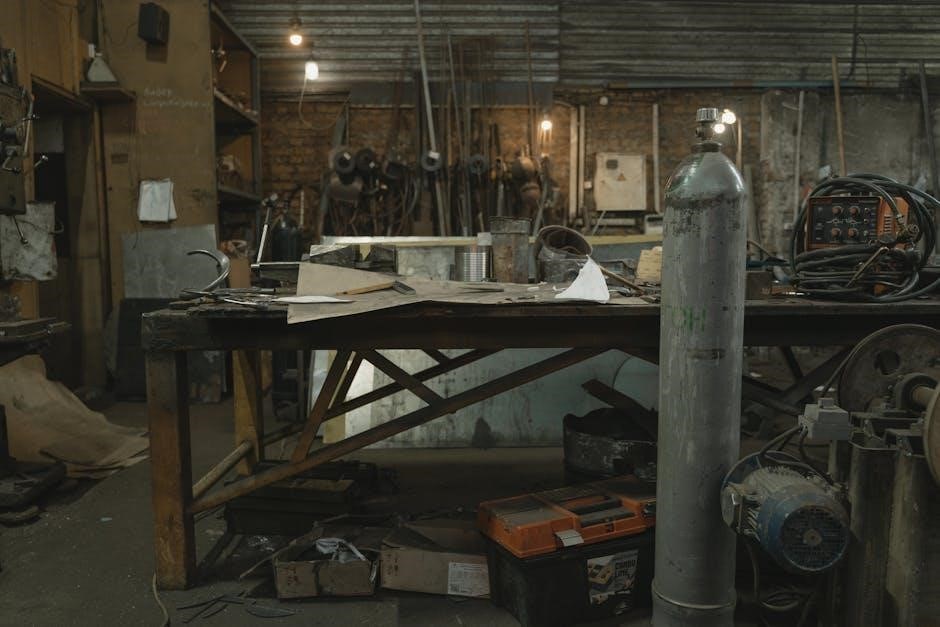
Applications of Welding in Industry
Welding is integral to automotive, aerospace, construction, and shipbuilding, enabling the fabrication of complex structures and machinery. It ensures durability and strength in industrial products and infrastructure.
Automotive and Aerospace Welding
In the automotive and aerospace industries, welding plays a critical role in manufacturing high-performance vehicles and aircraft. Advanced processes like MIG/MAG and TIG welding ensure precision and durability in lightweight materials. Laser welding is widely used for its high speed and accuracy, particularly in automotive assembly lines. Aerospace applications demand stringent quality control, with specialized techniques to handle materials like titanium and aluminum. These industries rely on welding to meet safety, efficiency, and cost-effectiveness standards, driving innovation in both sectors. The use of automated welding systems further enhances productivity and consistency in producing complex components for modern transportation and aviation needs.
Construction and Shipbuilding Welding
Welding is indispensable in construction and shipbuilding, enabling the assembly of large-scale structures like buildings, bridges, and marine vessels. Techniques such as Shielded Metal Arc Welding (SMAW) and Submerged Arc Welding (SAW) are commonly used for their reliability and adaptability. In shipbuilding, fluxes for submerged arc welding ensure strong, durable joints in thick steel plates. Construction projects often rely on SMAW for structural steel due to its versatility. These processes ensure high strength and resistance to environmental stresses, adhering to strict safety and quality standards like AWS and ISO. The precision and durability achieved through these methods are vital for constructing safe and long-lasting infrastructure and watercraft.
Industrial Maintenance and Repair Welding
Industrial maintenance and repair welding is critical for extending equipment lifespan and ensuring operational efficiency. Techniques like Shielded Metal Arc Welding (SMAW) and MIG/MAG are often used for repairing machinery, pipelines, and structural components. TIG welding is employed for precise, high-quality repairs on thin materials or intricate parts. Safety practices, including proper PPE and hazard control, are essential in industrial environments. Regular maintenance welding prevents costly downtime and enhances workplace safety. Adherence to standards like AWS ensures reliability and durability of repairs. This specialized welding supports industries by restoring equipment to optimal condition, minimizing operational disruptions, and maintaining production continuity effectively. Proper techniques and materials are vital for long-lasting results.
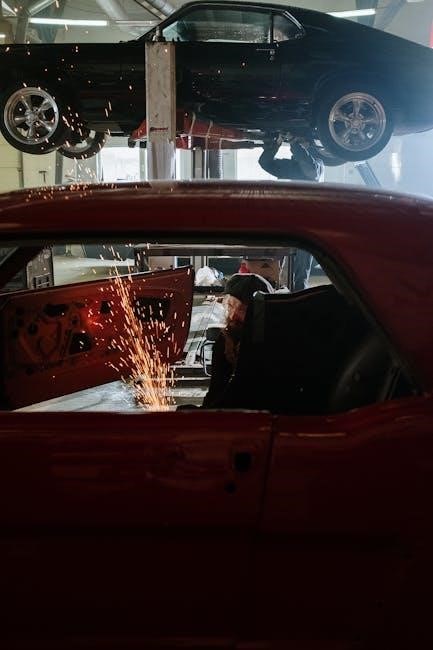
Resources for Welding Education
Essential welding handbooks, online guides, and PDF resources provide comprehensive knowledge on welding processes, safety, and best practices, supporting education and professional development in the field.
Essential Welding Handbooks and Manuals
Essential welding handbooks and manuals provide detailed insights into welding processes, safety protocols, and best practices. The AWS Welding Handbook and the Welding Handbook Ninth Edition are key resources, offering comprehensive guides on welding science, techniques, and materials. These manuals cover various welding processes, including MIG, TIG, and arc welding, and provide practical information on equipment setup, parameter selection, and troubleshooting. They also include sections on weld design, joint preparation, and quality control, making them invaluable for both professionals and beginners. Additionally, these resources often include cheat sheets, checklists, and charts to enhance learning and ensure safe, efficient welding operations.
Online Welding Guides and Tutorials
Online welding guides and tutorials offer accessible learning resources for professionals and novices. Websites provide step-by-step instructions, video tutorials, and downloadable PDFs covering welding processes like MIG, TIG, and arc welding. These resources often include safety tips, equipment setup guides, and troubleshooting advice. Many platforms also offer interactive content, such as webinars and forums, to address specific welding challenges. Additionally, online tutorials frequently include visual aids like diagrams and charts to enhance understanding. These resources are particularly useful for those seeking to improve their skills or stay updated on the latest welding techniques and industry standards without formal classroom training.
PDF Resources for Welding Professionals
PDF resources for welding professionals provide comprehensive guides, technical specifications, and practical insights. Essential documents include AWS standards, welding handbooks, and tutorial guides. These PDFs cover topics like welding processes, safety protocols, and material selection. Resources such as the Welding Handbook Ninth Edition and A Practical Guide to Welding Solutions are invaluable for professionals. They offer detailed information on MIG, TIG, arc, and plasma welding, as well as fluxes and shielding gases. These PDFs are often curated by industry experts, ensuring accuracy and relevance. They are easily accessible online, making them indispensable tools for enhancing welding knowledge and skills.

